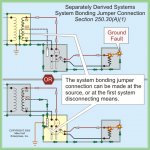Brownie326
New member
- Location
- Connecticut
Hey All:
I've got a few questions relating to transformers. I had a nice reference tool with pictures that
described transformer grounding that I can't seem to find, but a few coworkers and I had some
disagreement over a mock installation so here it goes. Situation: 480v primary 3 phase no
neutral to a disconnect, then to a transformer with 120/240v secondary.
The connection of the ground conductors in the disconnect became one talking point.
Another was connection to ONLY building steel, not any other electrode.
Finally, whether that GEC was routed through the secondary panel, and the bonding jumper
locations, versus being run in a seperate conduit to the electrode.
Any info would be appreciated, and if anyone knows the reference with pictures to which I'm
referring, I love to know. Thanks in advance!
I've got a few questions relating to transformers. I had a nice reference tool with pictures that
described transformer grounding that I can't seem to find, but a few coworkers and I had some
disagreement over a mock installation so here it goes. Situation: 480v primary 3 phase no
neutral to a disconnect, then to a transformer with 120/240v secondary.
The connection of the ground conductors in the disconnect became one talking point.
Another was connection to ONLY building steel, not any other electrode.
Finally, whether that GEC was routed through the secondary panel, and the bonding jumper
locations, versus being run in a seperate conduit to the electrode.
Any info would be appreciated, and if anyone knows the reference with pictures to which I'm
referring, I love to know. Thanks in advance!


